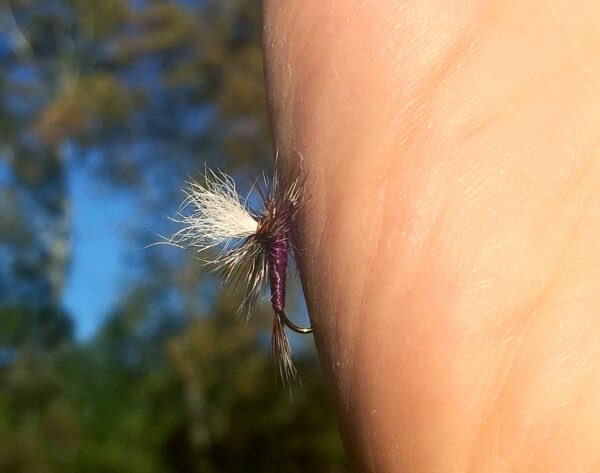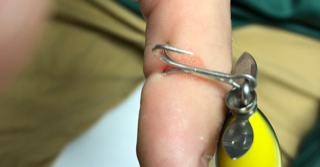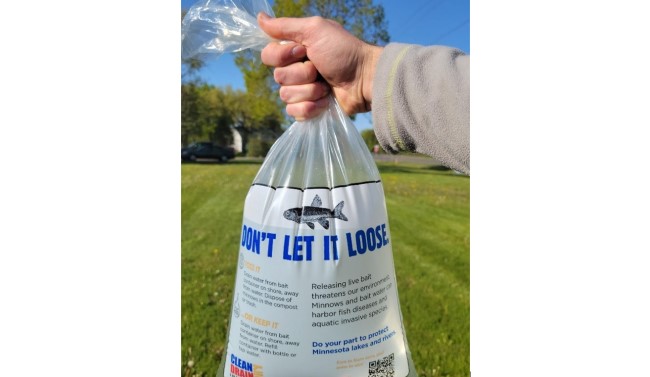Fishing
Fishing Foul-Ups: How to Un-Hook Yourself

Photo by Lynda Richardson/DWR
Editor’s Note: Today’s great outdoorsman tip comes to us courtesy of the Virginia Department of Wildlife Resources.
Have you ever had to end a great fishing trip early due to accidentally hooking yourself? Even advanced anglers may find themselves needing to remove an embedded hook in their skin. It’s one of the more common accidental injuries that fishermen endure. It’s essential to know when the injury is a painful but minor event that can be handled on the water…and when it’s time to go to the emergency room.
The technique for removing an embedded hook is actually quite simple. Start by cutting off a two- to three-foot long section of heavy monofilament, 15 or 20 lb. test line. If you’re fly fishing, 0x tippet will work fine.
Next, thread the monofilament between the shank of the hook and your skin, situating the loop of monofilament at the bend of the hook. Make sure you have at least 12” of monofilament on either side of the hook. With your thumb, press down on the shank of the hook until the shank is parallel to your skin. Once you have pushed down, quickly jerk the monofilament with your other hand in a motion parallel to the shank to remove the embedded hook. It’s a simple push-and-pull technique that is highly effective. I have performed this on myself many times, but it can certainly be beneficial to have a family member or friend assist you in the process, especially if you hooked yourself in the back or arm.

The tips below can help you in the process as well as decipher when it’s essential to seek medical attention:
- This technique is not recommended with treble hooks. Treble hooks on lures pose an entirely different situation and it’s best to seek medical attention if deeply impaled by two out of three treble hooks.
- Consider pinching the barbs on your hooks before fishing, especially for beginners. A barbless hook is a lot easier to remove than a barbed hook.
- Trust your gut—if you think you need medical attention, then it’s best to go to the emergency room. If you are hooked deeply in the neck or face, it is best to seek medical attention.
- Larger and heavier hooks, especially saltwater hooks that are deeply impaled, might also require a trip to the emergency room.
- Always wear a hat and polarized sunglasses when fishing on the water. Not only will sunglasses protect your eyes, but they also cut down against the glare and help you spot fish in the water.
- Spread out and give yourself ample casting space when fishing together with friends and family.
- Carry a first aid kit in your car when wade fishing or in your boat
See more strategies for removing embedded hooks, complete with diagrams.
— Alex McCrickard, Virginia DWR
-

 Hunting2 months ago
Hunting2 months agoDrain the Swamp: Corruption Scandal at Washington State’s Fish & Wildlife
-

 Adventure4 weeks ago
Adventure4 weeks agoDoes the “Big Beautiful Bill” Have a Public-Lands Wart?
-

 Adventure1 month ago
Adventure1 month agoHowling in Cuckoo: How Mexican Wolves are Fostered
-

 Gear2 weeks ago
Gear2 weeks agoLet Freedom RING! Primary Arms’ Independence Day Category Sale Starts NOW
-

 Adventure4 days ago
Adventure4 days agoREACTION: Trump’s Make America Beautiful Again Agenda
-

 Adventure3 weeks ago
Adventure3 weeks agoU.S. Bighorn Sheep Going Home to Canada
-

 Adventure2 months ago
Adventure2 months agoGoing Rodeo! BANISH Named the Professional Rodeo Cowboys’ Official Suppressor
-

 Adventure1 month ago
Adventure1 month agoYour Dream Hunt Could Be a Movie & Leupold Can Help





